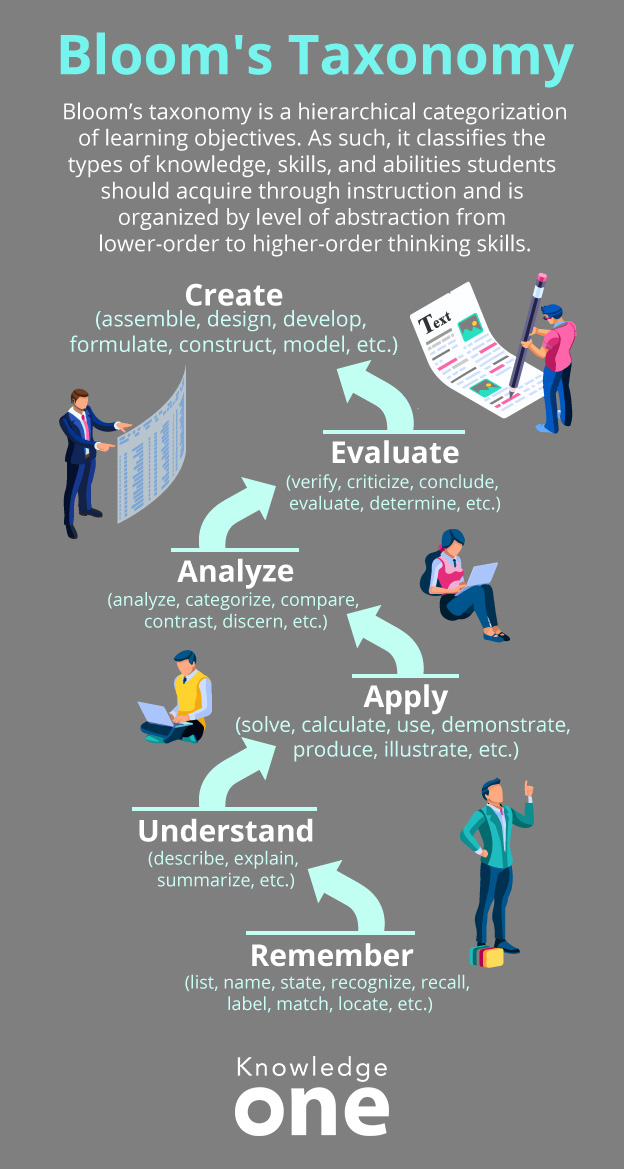Defining clear learning objectives is a challenging first step when creating a course. Viewed as the backbone of many educational strategies, Bloom’s taxonomy is a teaching tool that helps you design a course based on the outcomes you want to achieve. By providing a clear focus, both the teaching and the learning paths become more coherent and easier to envision. Let’s take a look at a few tips on how we can use Bloom’s taxonomy in practice.
What is Bloom’s taxonomy?

Bloom’s taxonomy is a hierarchical categorization of learning objectives. As such, it classifies the types of knowledge, skills, and abilities students should acquire through instruction and is organized by level of abstraction from lower-order to higher-order thinking skills.
- Remember (list, name, state, recognize, recall, label, match, locate, etc.)
- Understand (describe, explain, summarize, etc.)
- Apply (solve, calculate, use, demonstrate, produce, illustrate, etc.)
- Analyze (analyze, categorize, compare, contrast, discern, etc.)
- Evaluate (verify, criticize, conclude, evaluate, determine, etc.)
- Create (assemble, design, develop, formulate, construct, model, etc.)
What are learning objectives and why do they matter?
Learning objectives are the goals you want your students to achieve by the end of your course. Written as statements of observable and measurable behaviours, learning objectives are set at the course level and broken down by week or lesson. They represent the bedrock of effective course development and must, therefore, correspond with your content, teaching, and evaluation strategies.
How do you write clear learning objectives?
- Complete each statement as if you are talking to your students. You may find the following template helpful:
By the end of this (course/week/lesson), you will be able to: (state an observable and measurable action students must be able to perform to pass the course here); (list more actions until you have covered everything students will be evaluated on).
- Refer to Bloom’s revised taxonomy and categories of behaviours to identify accurate action verbs for each of your learning objectives.
- Start your learning objectives with action verbs (e.g., list, identify, recall, describe, explain, use, analyze, solve, assess, create, etc.).
- Verify that your learning objectives are specific, realistic, observable, and measurable behaviours that students will be assessed on to pass the course.
- Make sure you have one set of objectives for the course and another set of sub-objectives for each lesson.
How NOT to write learning objectives
Writing clear learning objectives can take practice. Here are some examples of incorrectly written objectives, the reasons they are problematic, and suggested alternatives.
| Problematic objective | Reason | Alternatives |
|---|---|---|
| Understand the fundamental principles of X | Not observable.
How can you measure your students’ level of understanding without behaviour that demonstrates this? |
|
| Explore the topic of X | Not specific or measurable.
How do you evaluate whether your students explored the topic in sufficient depth and with academic rigour? |
|
| Know the factors that affect X | Not observable or measurable.
How do you evaluate whether they know? |
|
| Reflect on the importance of X | Not observable or precise.
How can you tell that they reflected on the topic? |
|
| Write an effective academic paper… | Not specifically defined.
What makes an academic paper effective? |
|
Further Reading
-
A revision of Bloom’s taxonomy: An overview (Krathwohl, 2002)
-
Taxonomy for learning, teaching and assessing: A revision of Bloom’s taxonomy of educational objectives (Anderson & Krathwohl, 2001)
-
Taxonomy of educational objectives: The classification of educational goals (Bloom et al., 1956)









Leave A Comment